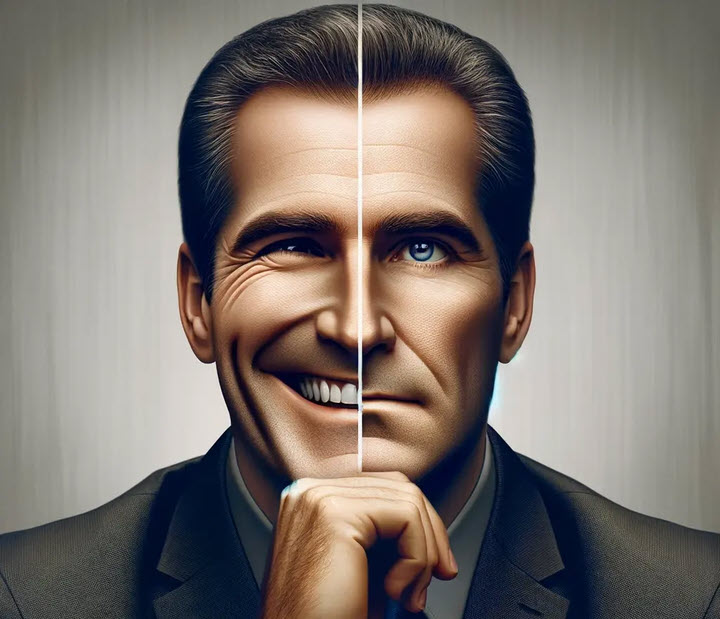
Incoherent leadership occurs when a leader holds contradicting beliefs and values arising from the presence of two contracting self-states: the true and pseudo-selves. This article describes what incoherent leadership is (and is not), what it looks like, where it comes from, what its impact on an organization can be, and what is required on the pathway to coherence.
What is Leadership Incoherence?
Incoherence is often confused with irrationality and amorality. Understanding the difference requires knowing the source of the disconnections.
- Irrationality is a disconnect between internal beliefs and intellectual processes, and external reality.
- Amorality is a disconnect between our internal beliefs and processes and external norms and mores.
- Incoherence is a contradiction between two of an individual’s beliefs or values, which are both generated internally.
For example, an irrational person might say, “I don’t care if the facts say it is a bad idea. I’m doing it anyway”. An amoral person may say, “I don’t care about what is good for the company. I’m doing what is best for me”. An incoherent leader may say, “I am a data-driven leader, but I’m choosing my gut instinct over the facts.”
Can you spot the incoherence in these examples?
- A CEO with a reserved parking spot near the door commissions a sign promoting “One Team” to hang above the entrance.
- A CHRO assigns the least approachable executive to give a town hall speech on the importance of being friendly and polite to each other.
- A candidate states that effective leaders never lie and should own it when they mislead, no matter the intention. Later in the interview, she shared an instance where she manipulated her team by filtering out negative information.
- A leader writes a company newsletter adamantly supporting women. At a dinner and wine tasting the following week, he explains why including two women on his executive committee at the same time would be counterproductive.
Examples of incoherence like these are all around us. A few blocks from my office, there is a newly famous statue of the “fearless girl” commissioned by a large hedge fund to promote gender equity in finance. The same year they placed the statue, the fund agreed to pay $5 million in fines for discriminating against women in their workplace.
Why Does Leadership Incoherence Exist?
The provocative comedian Chris Rock summed it up best: “When we first meet someone, we are not meeting them; we are meeting their representative.” Psychologists refer to the “representative” as the pseudo-self. It is formed by others’ thoughts and opinions and shifts as the people around them change. The pseudo-self is a pretend self that functions to manage relationships and bring people closer.
The authentic- or true self forms one’s thoughts and opinions independently of emotional pressure. This self may adopt the ideas of others if they are reasonable but never in an attempt to please or appease another. When the true self changes, it is due to a rational response to logic and data.
Incoherence is rooted in duplicity between two selves: the one we present to the world, our pseudo-self, and the other, our authentic—or true self. The greater the difference between these two selves, the greater the incoherence.
Those who study group dynamics and human systems attribute incoherence to two primary drives. One is individuation, which is a drive to develop a unique and independent identity. The other is togetherness, which is a drive to keep us connected to other people. These drives provide constant tension that profoundly influences our behavior.
The pseudo-self takes precedence over the true self when the drives are out of balance in favor of the togetherness dDrive. The result is incoherence in two forms:
- a contradiction between true self and pseudo-self; and
- a contraction between pseudo-self in the context of one group and pseudo-self in the context of another.
In the second condition, the number of potential contradictions is high and increases exponentially with the number of people they encounter.
The Impact of Leadership Incoherence
Makes Employees Crazy

Before Martin Seligman became widely regarded as the guru of positive psychology, he experimented on dogs by sending them contradictory and confusing messages and then punishing them for “wrong” choices or withholding expected rewards*. The dogs initially acted anxiously and eventually stopped responding. Even when the benefits were clear and the requirements simple, the dogs would not act. The result was a phenomenon called learned helplessness.
*Note: Seligman now believes these studies on dogs were unethical.
Before Martin Seligman became widely regarded as the guru of positive psychology, he experimented on dogs by sending them contradictory and confusing messages and then punishing them for “wrong” choices or withholding expected rewards*. The dogs initially acted anxiously and eventually stopped responding. Even when the benefits were clear and the requirements simple, the dogs would not act. The result was a phenomenon called learned helplessness.
*Note: Seligman now believes these studies on dogs were unethical.
Like the dogs in Seligman’s experiment, employees receive contradictory messages from incoherent leaders, rendering any action they take wrong. The initial reaction is anxiety paired with random activity that is often not aligned with company goals. Eventually, the anxiety gives way to apathy or resignation.
“Be still, for this initiative too shall pass.” – Frustrated Middle Manager
Reduces Trust in Leader’s Character
Employees perceive incoherent leaders as hypocrites and attribute the contradiction to character defects. This belief is rooted in the idea that trustworthy people are predictable, a trait that cannot exist within highly incoherent leaders.
Creates False Hope
One dynamic between the pseudo-self and the true self is between beliefs that are not rooted in fact but predicated upon the opinions and desires of others and beliefs that are generated by reason and logic. When the pseudo-self makes a statement, the true self eventually applies reason to it. The result is that the true self judges the statements of the pseudo-self as implausible.
When incoherent leaders make promises without considering the cost, they create false hope in their direct reports. I liken these leaders to the singer Meatloaf, who sang, I’d do anything for love (but I won’t do that), or the Gin Blossoms, who wrote:
Anywhere you go, I’ll follow you down / Any place but those I know by heart / Anywhere you go, I’ll follow you down / I’ll follow you down, but not that far
I’ve experienced two situations that illustrate the impact of false hope. While in the pseudo-self state, an incoherent leader told the director of human resources, “I’ll do anything to increase employee engagement,” He wanted her to like and respect him. Later, the leader’s true self applied logic to an engagement project she presented and rejected it for budget reasons. When his pseudo-self made the initial promise, he failed to consider the cost. After several similar instances, she quit.
In another instance, a leader’s pseudo-self told their newly formed team there is nothing more important than mentoring. The pseudo self was so focused on impressing his new team that he failed to consider the required time commitment. When a team member attempted to schedule an hour-long development session, his true self rejected the request because other matters were more urgent.
The Pathway to Coherence
The pathway to becoming a more coherent leader starts with rejecting Level One change and committing to the hard work associated with Level Two change. Here is a quick primer on the two.
Level One Change
Level One change involves improvements and adjustments that do not fundamentally alter the person’s core attributes. An incoherent leader attempts a level one change by switching from the core self to the pseudo self but does not attempt to reconcile the two.
For example, I worked with a highly ambitious and achievement-oriented leader. He quickly learned that he would not be promoted if he did not have a motivated, high-performing team. His initial approach was aggressive command and control. His team rejected this approach, and in response to their reaction, he made a Level-One switch to consensus-driven leadership. On his 360 reviews, he was rated as indecisive. The team determined his behavior in both cases.
Level Two Change
Level Two change is transformational or revolutionary, involving fundamental alterations to the self. In this case, Level Two change focuses on aligning the true self with the person we present to the world. After an effective Level Two change, a shift in opinions and actions is based on logic and reason.
For example, I coached a client who was convinced that increasing focus on ESG would make them more profitable. The primary focus on profit was a value imposed on him by the Board Chairperson. The initial attempts at integrating ESG programs were perceived as “greenwashing,” and neither the employees nor the market responded positively.
One day, he came to the session with a new energy after realizing that doing good was its own reward and that any profit that came from it was just a bonus. Control of his behavior shifted from his pseudo-self to his true self. Although he maintained his fiduciary duty to stakeholders, he no longer cared about the financial benefits of ESG programs. He started leading the ESG projects authentically.
Does Coherence Equate to Selfishness?
A common misconception is that the more we operate from our true selves, the less we care about the opinions and beliefs of others. This misconception makes a false logical leap that our true selves lack empathy.
Incoherence does not consider the morality of the beliefs or behaviors. The judgment is reserved for the ethicists. Instead, it focuses on authentic responses in which the thanks we say and do are consistent and that they reflect our true beliefs and values
For example, most would agree that opening doors for others is a good thing, but the behavior could be coherent or incoherent. Incoherent if I open doors for others because I fear the judgment of others who may be watching. Coherent if I do it because my true self determines that opening doors reflects my values. I am also coherent if I do not open doors for others because my core value is to never do something for someone they can do for themselves, even if others scowl at my perceived inconsiderateness.
My Journey Toward Coherence
My pathway to coherence began in my early 30s. At that time, I went on a journey of self-reflection in which I peeled back all of the layers of what I was presenting to the world. Eventually, I reached my true self. Some aspects of my true self made me proud, and others made me less happy. I then chose to accept them all and committed to aligning the self I show the world with my true self.
The other day, I was walking through the airport and noticed I smiled at everyone who made eye contact. I wondered why I do that, since I would likely never see these people again, and if I did, it is unlikely they would remember me. The answer was simple: it is who I am.
Twenty-five years later, I am still working on it. A leader committed to coherence is committed to a lifetime of integrating the two and accepting that full alignment is nearly impossible.
Summary
- Incoherent leadership happens when a leader holds contradicting beliefs and values, which lead to contradictory actions and decisions.
- The contradictions are the result of two self-states. One is the core or true-self, and the other is a pseudo-self that shifts beliefs and actions in response to others.
- Incoherent leadership undermines employee effectiveness, erodes trust in management, and creates false hope for the organization’s direction, thus undermining motivation.
- To become coherent, Incoherent leaders must align their “self-states,” which requires a level two change.
- Coherent leaders are not selfish leaders.
